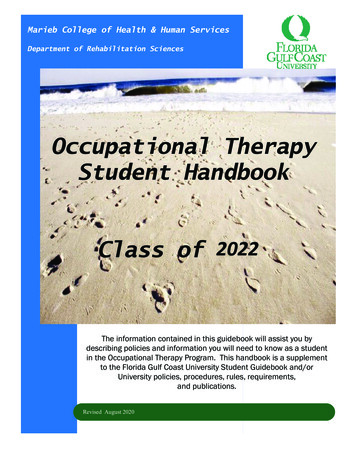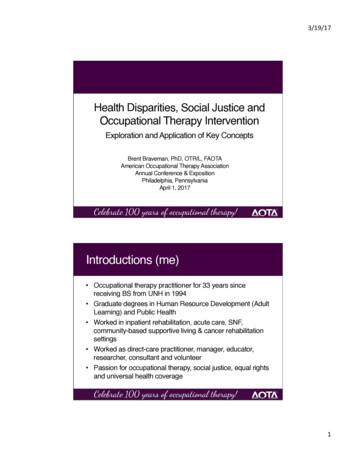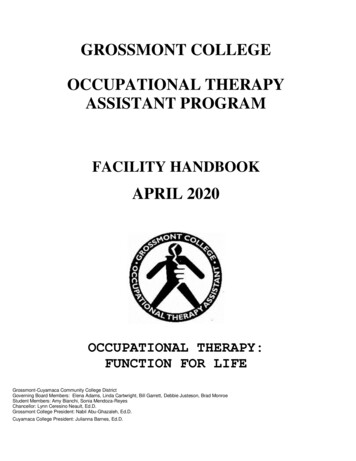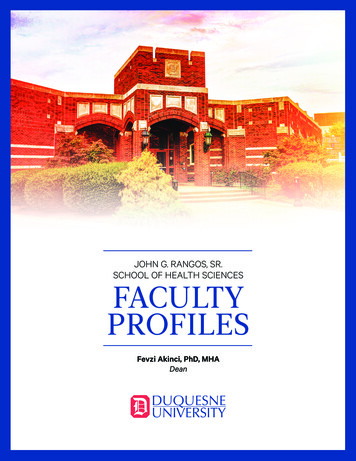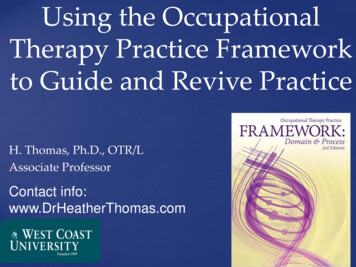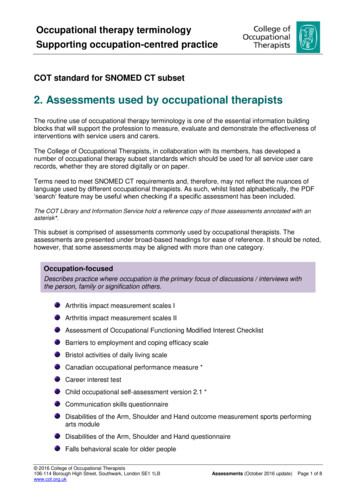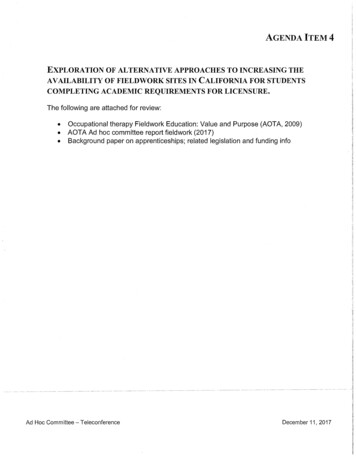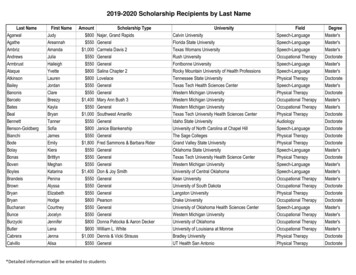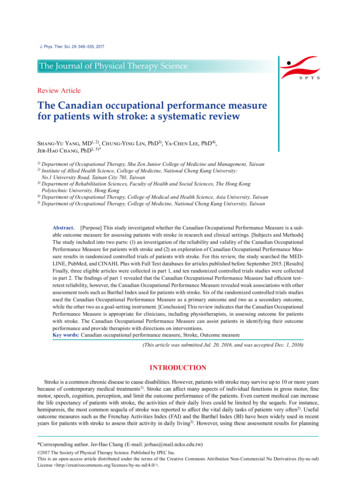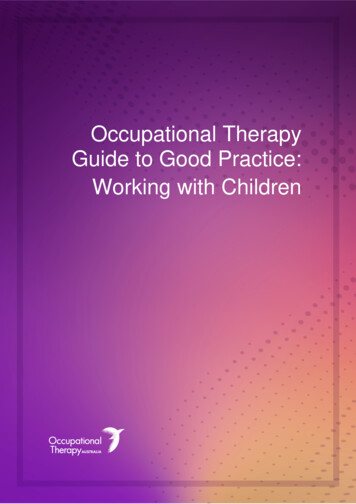
Transcription
Occupational TherapyGuide to Good Practice:Working with Children
About Occupational Therapy AustraliaOccupational Therapy Australia is the professional association for occupational therapists in Australia.Our members are qualified occupational therapists employed throughout the public and private sectors. Theyprovide health care, vocational rehabilitation, and consultancy to clients.Our mission is to provide member benefits through access to local professional support and resources, andthrough opportunities to contribute to, and shape, professional excellence.For more information about Occupational Therapy Australia, visit www.otaus.com.au. Occupational Therapy Australia 2016This work is copyright. You may download, display, print and reproduce this material in unaltered form only(retaining this notice) for your personal, non-commercial use or use within your organisation.Apart from any use as permitted under the Copyright Act 1968, all other rights are reserved.Occupational Therapy Australia reviews its publications on a staged basis. The Occupational Therapy Guideto Good Practice: Working with Children is due for review in May 2017.Requests for further authorisation should be directed to The National Manager: Professional Practice andStandards, care of:Occupational Therapy Australia 6/340 Gore StreetFitzroy VIC 3065orstandards@otaus.com.auOCCUPATIONAL THERAPY AUSTRALIA (2018)2
ContextThe Guide to Good Practice for Working with Children was developed by Occupational Therapy Australia’sPaediatric Taskforce over 18 months. It incorporates current evidence and practice knowledge and hasundergone consumer review.The primary intent of the Guide is to inform occupational therapists about good practice principles in theabsence of formalised clinical practice guidelines, and in response to Occupational Therapy Australia dataon practice queries.The Guide will be reviewed in one year with a view to inclusion of other child-based practices and settings,and other aspects based on feedback.AcknowledgementsOccupational Therapy Australia acknowledges the expertise and input of the following members of theOccupational Therapy Australia Paediatric Taskforce in authoring the Guide to Good Practice:Nicole Brown; Nikki Chegwyn; Rachelle Coe; Elizabeth Edgar; Dr Elspeth Froude; Cate Hilly; Deb Hopper;Dr Fiona Jones; Dr Annette Joosten; Aneesa Kathrada; Erin Kelly; Emma King; Caroline Mills; Jacky Peile;Celeste Riach; Liz Springfield; Lisa Vale; and Tara Whiteford.IntroductionThe Occupational Therapy Guide to Good Practice for Working with Children provides practice guidelines foroccupational therapists who work with children (aged 0-18 years) and their families/caregivers. This can beused as a reference for occupational therapists, consumers, and organisations. It outlines expectations forgood practice.The need for a good practice guide was identified by Occupational Therapy Australia’s Paediatric Taskforce,which was established in July 2014 to advise the National Professional Practice and Standards Portfolio andthe Boardof Occupational Therapy Australia on issues relevant to paediatric practice. The Guide was developed by theNational Paediatric Steering Group of Occupational Therapy Australia with input from the National PaediatricReference Group and a range of other key stakeholders including the Board of Occupational TherapyAustralia.The Guide incorporates information from a range of sources: experienced occupational therapists practicingin the field, researchers, academics, current evidence, and governing bodies relevant to occupationaltherapy practice and children.The information in this Guide was developed to be used by occupational therapists who work with childrenand their families/caregivers to articulate what is expected of occupational therapists who work withthese individuals. Particular acknowledgement is made of the 2007 UK Guide to Good Practice for PaediatricPhysiotherapists (Association of Paediatric Chartered Physiotherapists), which informed the framework forthis document.The Guide is intended to complement other key documents including the AHPRA Code of Conduct, theOccupational Therapy Australia Code of Ethics (2001), and the Occupational Therapy Australia CompetencyStandards for Entry-Level Practitioners (2010). A range of other regulatory and legislative documents mayapply depending on jurisdiction, service type, and employment structure.OCCUPATIONAL THERAPY AUSTRALIA (2018)3
Table of ContentsContext .3Acknowledgements .3Introduction .3Table of Contents .4Section 1: Occupational therapy as a profession.6What is occupational therapy? .6Occupational therapy with children .6Section 2: Occupational therapy practice .6Legal and ethical frameworks .6Consent in occupational therapy.7What is the role of the occupational therapist in safeguarding children? .8Checking staff against criminal registers .8Respect, privacy and confidentiality.8Cultural safety and responsiveness .8Fees .9Advertising .9Use of titles and descriptors . 10Continuing professional development . 10Section 3: Occupational therapy practice with children . 11Evidence-based practice: knowledge for practice, applying knowledge in practice, competencies andstandards . 11Collaborative practice . 12Settings and contexts . 12Autonomy and delegation . 12Section 4: Providing high quality services for children and their families . 13What do occupational therapists do? . 13Occupational therapy process . 13How do occupational therapists deliver their services?. 14Record keeping and documentation . 15Section 5: Child-related policy . 18Safeguarding children . 18Standards for disability services . 19Education . 19Section 6: Funding Schemes . 19Access to Allied Psychological Services (ATAPS). 19OCCUPATIONAL THERAPY AUSTRALIA (2018)4
Better Access to Mental Health (BAMH) . 19Better Start for Children with Disability Initiative . 19Chronic Disease Management Plan . 20Enhanced Primary Care . 20Helping Children with Autism . 20Medicare . 20National Disability Insurance Scheme (NDIS) . 20Section 7: Useful general information . 21Useful terms and definitions . 21References . 24OCCUPATIONAL THERAPY AUSTRALIA (2018)5
SECTION 1: Occupational therapy as a professionWhat is occupational therapy?Occupational therapy is a client-centred health profession concerned with promoting health and wellbeingthrough occupation. Occupations refer to the everyday activities that people do as individuals, in families,and with communities to occupy time and bring meaning and purpose to life. Occupations include thingspeople need to, want to, and are expected to do (World Federation of Occupational Therapists, 2011). Theprimary goal of occupational therapy is to enable people to participate in their daily occupations or activities.Occupational therapists complete a university degree at undergraduate or graduate entry Masters level thatprovides them with a knowledge base in occupational therapy theory and science, neurology, anatomy,physiology, kinesiology, lifespan including child development, sociology, psychology, psychosocialdevelopment, activity-task-environment analysis, and therapeutic techniques.Occupational therapy with childrenOccupational therapists enable children to do the activities they need or want to do (performance), and tofacilitate children’s engagement in their roles (participation) within their everyday lives. Occupationaltherapists aim to enable and optimise children’s occupational performance and participation to fulfil their liferoles.Occupational therapists who work with children require specific knowledge and skills in the areas of: child and adolescent development occupations of children (schoolwork, play/leisure, self-care, rest/sleep) child- and family-centred practice assessment and outcome measurement goal setting and occupational therapy process evidence-based interventions.Occupational therapists may work in the child’s home and community including early intervention,educational settings such as schools and universities, hospital and health settings, and in private practice.SECTION 2: Occupational therapy practiceLegal and ethical frameworksWHAT ARE THE LEGAL AND ETHICAL FRAMEWORKS THAT GOVERN OCCUPATIONAL THERAPY?Occupational therapists are registered health professionals who are required to adhere to rules andstandards of the Occupational Therapy Board of Australia, and the relevant legal and policy frameworks ofthe country.In Australia, there are several types of laws that therapists need to follow and it is important to be aware ofthe relevant law for the state or territory where the therapist is practicing. It is the responsibility of thetherapist to be aware of state, territory, and national law for both the profession and general consumers.OCCUPATIONAL THERAPY AUSTRALIA (2018)6
The Health Practitioner Regulation National Law Act 2009 (the National Law) came into effect on 1 July2010. The National Law enabled a National Registration and Accreditation Scheme, established theOccupational Therapy Board of Australia, appointed a Tribunal for the purpose of law, imposed standards ofconduct for the health professions, and placed restrictions on how health services can be advertised.WHO REGULATES OCCUPATIONAL THERAPY PRACTICE?The Australian Health Practitioner Regulation Agency (AHPRA) supports the Occupational Therapy Board ofAustralia in regulating the occupational therapy profession.Occupational therapists must ensure they meet the relevant registration guidelines annually. Therapists mustdeclare an annual statement and pay a fee to remain registered. The declaration in the annual statementincludes whether: the therapist has met the recency of practice requirements stated in the Board’s registrationstandard the therapist has met the Board’s continuing professional development (CPD) requirements as setout in the Board’s CPD registration standard during the previous registration period the therapist has practised in accordance with the requirements of the Board’s professionalindemnity insurance (PII) arrangements registration standard, and whether the therapist commits topractise in accordance with that registration standard if registration is renewed there was any change in the therapist’s criminal history during the previous registration period the therapist has any other criminal history that has not been disclosed to AHPRA.The Occupational Therapy Board of Australia provides a Code of Conduct to guide practice and assist in thedelivery of effective services within an ethical framework (Occupational Therapy Board of Australia, 2012).Within this Code there are sections to help shape practice including working with children (OccupationalTherapy Board of Australia, 2012). This Code aims to help protect the public by setting and maintainingstandards of good practice that must be adhered to by registered occupational therapists. Failure to complywith these standards may have consequences for odes-Guidelines/Code-of-conduct.aspxETHICAL FRAMEWORK THAT GOVERNS OCCUPATIONAL THERAPYOccupational Therapy Australia uses a Code of Ethics that provides clear and moral ethical parameters foroccupational therapy practice (OT Australia, 2001) to promote and maintain high standards of ethicalbehaviour. Adherence to the Code of Ethics supports practice aligned with bio-ethical principles ofbeneficence, non- maleficence, honesty, veracity, confidentiality, justice, respect, and autonomy.Consent in occupational therapyOccupational therapists need to be aware of obtaining consent when working with children. It is theresponsibility of the occupational therapist determine which departmental rules apply (for exampleDepartment of Education), and which state/territory and federal legislation is current and applicable.Consent to assess and intervene must be given voluntarily, without any duress or force or deceit. A personproviding consent must be able to understand and comprehend the situation and requirements. Consent canbe provided verbally or non-verbally depending on the child’s abilities. Full consent is required unlessotherwise mandated under National Law.OCCUPATIONAL THERAPY AUSTRALIA (2018)7
What is the role of the occupational therapist in safeguarding children?Occupational therapists are expected to apply their professional expertise to observe, monitor, and reportsituations where the well-being of their client/s is at risk in order to provide advocacy and protection for thechild. Within Australia occupational therapists need to appraise themselves of and comply with federal andstate legislation regarding reporting of suspected child harm within the jurisdiction that they practice.From an international perspective, occupational therapists working with children need to be aware of theUnited Nations Convention on the Rights of the Child (United Nations Treaty Collection, Convention on theRights of the Child. 1989) which is a universally agreed set of non-negotiable standards and obligations forall children. The rights of the child are also reflected in the United Nations Convention on the Rights ofPersons with Disabilities (2006), which has been ratified by Australia. Additionally, this Convention offersspecific guidance upon rights to a range of disability supports. It is available ull.shtml.Checking staff against criminal registersEach Australian state jurisdiction has different compliance requirements for a Working with Children Check.This Check is generally mandatory and needs to be completed prior to commencement of practice withchildren. It is the responsibility of the occupational therapist to ensure they comply with the laws in thejurisdiction and the organisation that they are working within. Links to information on Working with ChildrenChecks for each state/ territory can be found online.Respect, privacy, and confidentialityOccupational therapists are required to comply with AHPRA guidelines, state and federal laws, and theiremployer in regard to the maintenance and protection of their client’s privacy and confidentiality. Furtherinformation can be found at: es.aspxCultural safety and responsivenessCulturally safe practices focus on the level of safety felt by an individual seeking health care with anemphasis placed on assisting the health worker to understand processes of identity and culture, and thushow power imbalances can be culturally unsafe (Downing, Kowal & Paradies, 2011).Occupational therapists are expected to provide services that are responsive and appropriate in the culturalcontext in which they practice. Occupational therapists recognise the uniqueness of each client, family, andcommunity they work with by ensuring that all aspects of their service provision respect cultural values andbeliefs. This requires occupational therapists to work in partnership with clients, families, and communities totailor communication, occupational therapy assessments, and interventions to meet the needs of the childand family’s cultural context. Occupational therapists need to understand the occupations, tasks, androutines of the child’s and family’s daily life, and deliver a service that is culturally appropriate and meets thefamily’s needs.The delivery of culturally appropriate services in partnership with Australian Aboriginal and Torres StraitIslander people is of particular focus to support the health and well-being of these communities. Thisrequires time to build a relationship with the child and family, ensure ease of access to services and thereferral process, and culturally appropriate assessment, intervention, and documentation.In terms of responsiveness to family culture, occupational therapists are expected to provide services withinthe context of the family and its cultural beliefs and values, understanding that the modern family unit is adiverse and changing configuration of involved caregivers and children. For example, choice of culturallyinclusive words to describe significant others may include next of kin, circle of support, kinship carer, and/orparent/caregiver.OCCUPATIONAL THERAPY AUSTRALIA (2018)8
FeesInformation regarding fee for services must be clearly documented and available. It can sometimes bedifficult to provide accurate pricing for occupational therapy services due to the nature of services andnumber of variables in intervention. If fees and price information are advertised then price information shouldbe clear, with all costs involved and out of pocket expenses clearly identified with any conditions or othervariables disclosed. Fees might vary depending on the assessment forms required, specialised orconsumable equipment that needs to be used, or reporting requirements additional to an occupationaltherapy report. If a private practice occupational therapist is required to assume a case manager or keyworker role, fees may be charged for contributing to additional requests for communication such as engagingin meetings, writing reports, and providing consultation to other team members in conjunction of the familyand child.AdvertisingAdvertising is a useful way to communicate about occupational therapy services so families can makeinformed choices. As per the AHPRA guidelines, advertising should not be false or misleading. Advertisingincludes paper based, web-based and social network media.Advertising may include: office details and contact hours fees qualifications and experience of occupational therapists memberships of professional associations.Advertising should not: include testimonials from former clients of the service offer gifts, prizes, or bulk discounts for taking part in therapy services encourage indiscriminate or unnecessary use of occupational therapy services create unreasonable expectation of benefits of treatment make “time limited” offers that encourage a person to make decisions under the pressure of timeand money and not about their health care needs.Caution should be taken in using scientific information in advertising. Clear information should be providedregarding the evidence base of any intervention being offered.HELPFUL QUESTIONS TO CONSIDER WHEN ADVERTISINGPractitioners who are considering the use of titles, words, or letters to identify and distinguish themselves inadvertising (other than those professional titles protected under the National Law for their profession) areencouraged to ask themselves the following questions: Is it appropriate for me to use this title, qualification, membership, words or letters in advertisingmaterial? Am I skilled in the services I am advertising? If I display or promote my qualifications in advertising materials, is it easy to understand? Is there any risk of people being misled or deceived by the words, letters, or titles that I use? Is the basis for my use of title, qualification, membership, or other words or letters:orelevant to my practice?ocurrent?OCCUPATIONAL THERAPY AUSTRALIA (2018)9
g-regulatedhealth- services.aspxUse of titles and descriptorsProviding information about qualifications and experience may assist families in choosing an occupationaltherapy service for their child.The title “Occupational Therapist” is protected under the National law. Occupational therapists cannot callthemselves a “specialist” occupational therapist or practitioner or imply that they are one. Using the phrase“specialising in X” may be misleading. Occupational therapists should not use words, letters, or titles thatmay mislead a family or consumer into thinking that the therapist is more qualified or competent than anotherprofessional occupational therapist with the same registration. Guidelines from AHPRA suggest occupationaltherapists should advertise the amount of experience they have working with particular children. (Forexample, “Specialist Occupational Therapist for children with autism” may be misleading and cannot beused; instead, “Occupational Therapist with more than 10 years’ experience working with children withautism” would be more suitable.)Where occupational therapists use the title “Dr”, they should clarify that they are not a medical practitioner bystating “Occupational Therapist” or stating whether they hold a doctorate (e.g. HScD or PhD).Continuing professional developmentContinuing professional development (CPD) is the means by which therapists maintain, improve, andbroaden their knowledge, expertise, and competence, and develop the personal and professional qualitiesrequired throughout one’s professional life.All practising occupational therapists must undertake a minimum of 30 hours of CPD annually as arequirement of registration.CPD REQUIREMENTSFrom 1 December 2013, all registered occupational therapists must complete 30 hours of CPD each year(every 12 months).KEY POINTS: CPD CPD activities should have clear goals and outcomes Keep evidence of completed CPD activities in a CPD portfolio, and retain this evidence for fiveyears Comply with the Occupational Therapy Board of Australia’s CPD registration standard, so makesure you familiarise yourself with this document and the accompanying CPD guidelines and factsheet Make a declaration at registration renewal about CPD activities. A false statement is grounds forthe Board to refuse .aspxOCCUPATIONAL THERAPY AUSTRALIA (2018)10
SECTION 3: Occupational therapy practice withchildrenEvidence-based practice: knowledge for practice, applying knowledge in practice,competencies, and standardsScope of practice is the level at which all graduates of Australian occupational therapy programs can work.The Australian Minimum Competency Standards for New Graduate Occupational Therapists (2010)represents the minimum knowledge, skills, and attitudes the profession believes are essential for adequate,safe, and competent practice in new graduate occupational therapists (Occupational Therapy Australia,2010, p3.). There are seven units of competence: Professional Attitudes and Behaviour Roles, Performance, and Functional Level of Individuals and Groups Implementation of Individual and Group Interventions Evaluation of Occupational Therapy Programs Documentation and Dissemination of Professional Information Professional Education Management of Occupational Therapy Practice.Occupational therapists work collaboratively with the family and the child to address the child and family’soccupational needs and goals based on their priorities.Occupational therapists are evidence-based practitioners who integrate the best research evidence withclinical expertise and with the values and circumstances of the person with whom they are working (seeUseful terms and definitions on page 21 for explanations).Occupational therapists must adhere to evidence-based practice as (a) it is part of their registrationrequirements;(b) clients expect and deserve services based on best available evidence; and (c) funding bodies requireevidence for continuation of services.Occupational Therapy Australia supports the following considerations: Occupational Therapy Australia recognises that the strength of evidence for the effectiveness ofany specific occupational therapy intervention or approach is a function of a number of factors.These include relevant research studies, as outlined in the GRADE criteria(www.bmj.com/content/336/7650/924), including: the study design; risk of bias; directness of theevidence; consistency and precision of the results; and risk of publication bias The quality of the available evidence impacts on the profession’s standing in the health andgeneral communities and is the responsibility of the profession and our association Occupational Therapy Australia acknowledges that limited or absence of research regarding anoccupational therapy intervention does not always mean that it is ineffective or inappropriate When there is no evidence for effectiveness of an intervention, parents should be advised and theintervention should be used with regular reviews to ensure that the intervention is meeting thegoals of the client, using an outcome measure Occupational Therapy Australia acknowledges that occupational therapists have a range of clinicalquestions that extend beyond those about intervention effectiveness. These may include questionsabout the accuracy of an assessment/s, prognosis (i.e. the likely outcome for a client, either with orwithout intervention), clients’ experiences and concerns for a particular situation, or the frequency,aetiology, or risk factors for a condition occurringOCCUPATIONAL THERAPY AUSTRALIA (2018)11
The best availab
The Occupational Therapy Board of Australia provides a Code of Conduct to guide practice and assist in the delivery of effective services within an ethical framework (Occupational Therapy Board of Australia, 2012). Within this Code there are sections to help shape practi
